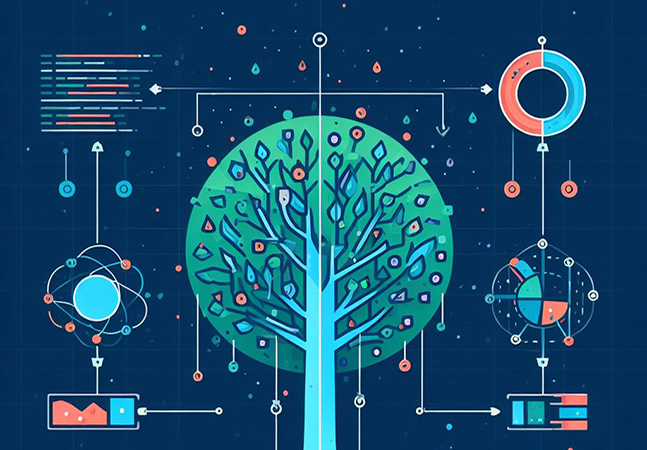
Dr. James McCaffrey of Microsoft Research presents a full-code, step-by-step tutorial on creating an approximation of a dataset that has fewer columns.
- By James McCaffrey
- 07/15/2024

Dr. James McCaffrey from Microsoft Research presents a full-code, step-by-step tutorial on using the LightGBM tree-based system to perform binary classification (predicting a discrete variable that has exactly two possible values).
- By James McCaffrey
- 07/01/2024

Here's a complete end-to-end demo of what Dr. James McCaffrey of Microsoft Research says is arguably the simplest possible classification technique.
- By James McCaffrey
- 06/17/2024

Dr. James McCaffrey of Microsoft Research presents a full-code, step-by-step tutorial on this powerful machine learning technique used to predict a single numeric value.
- By James McCaffrey
- 06/05/2024

Dr. James McCaffrey of Microsoft Research presents a full-code, step-by-step tutorial on a "very tricky" machine learning technique.
- By James McCaffrey
- 05/15/2024

Dr. James McCaffrey of Microsoft Research provides a full-code, step-by-step machine learning tutorial on how to use the LightGBM system to perform multi-class classification using Python and the scikit-learn library.
- By James McCaffrey
- 05/02/2024

Dr. James McCaffrey of Microsoft Research tackles the process of examining a set of source data to find data items that are different in some way from the majority of the source items.
- By James McCaffrey
- 04/15/2024

Chances are if you've had many coding interviews you've been presented with a poker problem. Here's a great take from Dr. James McCaffrey of Microsoft Research.
- By James McCaffrey
- 04/04/2024

Dr. James McCaffrey of Microsoft Research presents a full-code, step-by-step example of machine learning technique to visualize high-dimensional data.
- By James McCaffrey
- 03/15/2024

Dr. James McCaffrey of Microsoft Research presents a full-code, step-by-step tutorial on technique for visualizing and clustering data.
- By James McCaffrey
- 03/01/2024

Dr. James McCaffrey of Microsoft Research presents a full-code, step-by-step tutorial on a classical ML technique that transforms a dataset into one with fewer columns, useful for creating a graph of data that has more than two columns, for example.
- By James McCaffrey
- 02/16/2024

Dr. James McCaffrey of Microsoft Research presents a full-code, step-by-step tutorial on an implementation of the technique that emphasizes simplicity and ease-of-modification over robustness and performance.
- By James McCaffrey
- 02/01/2024

Transforming a dataset into one with fewer columns is more complicated than it might seem, explains Dr. James McCaffrey of Microsoft Research in this full-code, step-by-step machine learning tutorial.
- By James McCaffrey
- 01/17/2024

Dr. James McCaffrey of Microsoft Research guides you through a full-code, step-by-step tutorial on "one of the most important operations in machine learning."
- By James McCaffrey
- 01/03/2024

Spectral clustering is quite complex, but it can reveal patterns in data that aren't revealed by other clustering techniques.
- By James McCaffrey
- 12/18/2023

K-means is comparatively simple and works well with large datasets, but it assumes clusters are circular/spherical in shape, so it can only find simple cluster geometries.
- By James McCaffrey
- 12/01/2023

Compared to other clustering techniques, DBSCAN does not require you to explicitly specify how many data clusters to use, explains Dr. James McCaffrey of Microsoft Research in this full-code, step-by-step machine language tutorial.
- By James McCaffrey
- 11/15/2023

Dr. James McCaffrey of Microsoft Research explains GMM clustering in a full-code, step-by-step tutorial, noting his data scientists colleagues have different opinions about the complicated technique.
- By James McCaffrey
- 11/01/2023

Compared to other regression techniques, a well-tuned neural network regression system can produce the most accurate prediction model, says Dr. James McCaffrey of Microsoft Research in presenting this full-code, step-by-step tutorial.
- By James McCaffrey
- 10/18/2023

Dr. James McCaffrey of Microsoft Research says the technique is easy to tune, works well with small datasets and produces highly interpretable predictions, but there are also trade-off cons.
- By James McCaffrey
- 10/02/2023

GPR works well with small datasets and generates a metric of confidence of a predicted result, but it's moderately complex and the results are not easily interpretable, says Dr. James McCaffrey of Microsoft Research in this full-code tutorial.
- By James McCaffrey
- 09/15/2023

The main advantages of KNNR are simplicity and interpretability, says Dr. James McCaffrey of Microsoft Research in presenting this full-code, step-by-step tutorial.
- By James McCaffrey
- 09/05/2023

KRR is especially useful when there is limited training data, says Dr. James McCaffrey of Microsoft Research in this full-code, step-by-step tutorial.
- By James McCaffrey
- 08/15/2023

Implementing LRR from scratch is harder than using a library like scikit-learn, but it helps you customize your code, makes it easier to integrate with other systems, and gives you a complete understanding of how LRR works.
- By James McCaffrey
- 08/01/2023

Dr. James McCaffrey of Microsoft Research offers a full-code, step-by-step tutorial for this technique, especially useful when there is limited training data.
- By James McCaffrey
- 07/18/2023